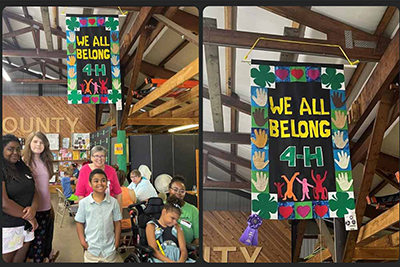
ICI, UM EXTENSION PARTNER FOR 4-H YOUTH
01/18/2024

|
| Two photos showing a 4-H banner at a community event. The photo on the left shows people at the event with the banner over their heads. The photo on the right is a close-up of the banner. |
Talking with staff and volunteer 4-H leaders in a recent training session, Darcy Cole holds up multi-sensory rule paper, with raised lines. There are timers, a chime, and small fidgets commonly seen in schools, offices, and other spaces.
Using common items to assist club members to get the most out of a meeting not only keeps down the cost of accommodations, it helps to make those accommodations universal – available to 4-H members with and without disabilities.
“Some of these tools might be designed for people with disabilities, but good accommodations can be useful for everyone in the group,” said Cole, a regional 4-H Extension educator.
Working with Minnesota 4-H, part of University of Minnesota Extension, the Institute on Community Integration (MN UCEDD) has created accommodation kits featuring these and other tools that are now available to clubs across the state. They help with decreasing stress, enhancing learning, and building fine-motor skills to improve the 4-H club experience for all participants. Beyond the physical tools in the kit and how to use them in different scenarios, the training involved tips and sharing stories amongst club leaders about ways to more fully include youth with disabilities. Adopting a 5-point scale for communicating feelings has been an important behavior support tool, for example.
Sarah Hall, an ICI research associate, helped create the kits as part of a Minnesota Department of Human Services grant and has continued to work with 4-H to implement strategies for increasing inclusivity in individual 4-H clubs. The work was part of a more than 2-year effort to support youth with disabilities and youth with disabilities from historically marginalized racial and ethnic groups to participate in 4-H. ICI’s Charity Funfe Tatah Mentan helped lead an early phase of the project that focused on engaging youth with disabilities from underserved and immigrant communities.
“We wanted to create training that speaks to the 4-H philosophy of youth themselves being leaders and involved in every step,” said Hall, who as a youth was part of 4-H for many years, including being a member of a local, neighborhood club and a special-interest club focused on science. “We wanted to give them activities they could adapt to their own clubs, whether they have five people or 40, based on their interests and abilities.”
The partnership also involved bringing in speakers to work with 4-H staff, volunteers, and youth leaders on better understanding disability.
“We did one session describing the work of direct support professionals and we had a parent of someone with disabilities come and talk about all of the things these professionals do, so youth could perhaps see themselves in that role,” Hall said. “A couple of the youth said that even though they may not want to do that work directly, they could see that they will be working with people with disabilities in the future no matter what career path they choose, so they were excited to know about this field and all of the related fields. And then to set that in the larger conversation about being more inclusive was exactly what we wanted to do.”
4-H staff and parent volunteers have also found the tools valuable.
Cole, who has family members with disabilities and is a 4-H club leader in addition to her Extension role, said the conversations and the knowledge transferred in the training sessions about the values of 4-H as a whole, as well as about making 4-H experiences better for youth with disabilities, have been transformative.
“In the past, young people who came to horse camp with an aide, for example, might simply have attended but not interacted with the group, but putting some strategies in place, you end up finding that one area of passion and they are completely into it and ready to help you lead the activity,” she said.
“As a parent, I know it can be hard to find where you fit in, and where your kids fit in, and if we can be that place, I think that’s really important. Everybody has people with disabilities in their community and everyone can connect and see the value of engaging more people in their programs.”